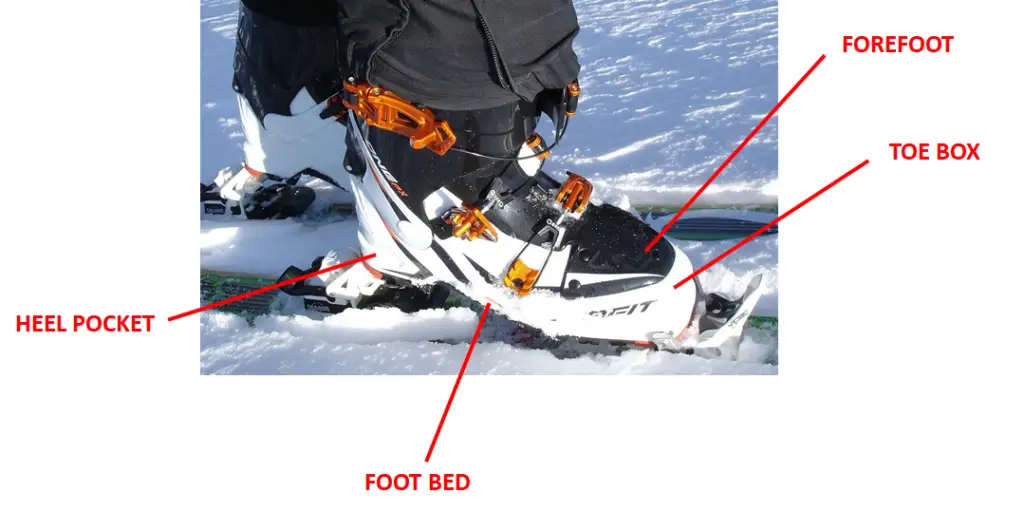Arguably your most important piece of skiing kit, along with your skis are your boots! These affect not only your comfort and enjoyment out on the slopes, but also your performance, rate of improvement and ability!
With such an important piece of kit, it is essential that they are right for you! That means that their fit in particular needs to suit you and be comfortable.
When buying your new pair of ski boots, you might wonder how easily it will be to break in your boots.
However, it is possible that after getting used to your new boots that they still might not fit right. This may mean you need a professional boot fitters’ guidance about if you need to have your boots professionally stretched.
If you want to know more about this topic, keep reading for everything you need to know about boot stretching!
Will your ski boots stretch out?
Your boot lining may stretch very slightly when you break in your new ski boots. Your ski boot can also be stretched by a professional boot fitter. How easy this is will depend on the boot material and type of boots you have.
With that in mind, you might wonder how professional boot stretching is done, how much your boot can be stretched and what other alternatives there are for this.
Breaking in Ski Boots
When you buy brand new ski boots, they have not yet had chance to adapt slightly to the shape of your foot. This will happen only with the boot lining, as the boot shell will not stretch and change on its own during this breaking in process.
However, the lining of your boots will stretch and change slightly to suit the shape of your individual foot.
Don’t expect enormous changes and be sure that you are getting the right boot size in the first instance whenever you buy new ski boots. Consulting with a professional boot fitter is the best way to ensure that you are buying the right ski boot for you.
Breaking in ski boots can take a little while. This process may take you wearing the boots a number of times and for a little while in order to allow the boot lining to properly suit the size and shape of your foot.
Speak to a professional boot fitter about how your boot should fit and if you have the right sized boots before breaking in boots in order to prevent them from hurting your feet.
Boot Liners
The ski boot lining is the inner lining of the boot which your feet will be in contact with.
This lining is much softer than the hard-outer shell of the boot, and can change shape and stretch slightly as your wear your boot more and more and it adapts to the shape of your foot.
Speak to a professional boot fitter if you are wondering how a boot should fit when you first buy it and what sized boot you should buy.
Boot Shell
The boot shell is the hard, outermost layer of the boot. The material of this boot shell, as well as the style and type of boot it is, will determine if it can be and how easy it will be to stretch without damaging the boot.
This boot shell can be the main factor determining what type of boot you have (either mono-injected or dual-injected boots).
The boot shell can also be made from different types and strengths of material depending on how advanced of a skier you are. This can be a key factor in determining if your boots can be stretched, and how easy this will be without damaging your boots.
Boot Type
Mono-injected boot
Mono-injected boots are formed of just one single piece of outer shell material. This generally makes them much easier to stretch than dual-injected boots.
Dual-injected boot
Dual-injected boots are instead formed of two pieces or types of outer shell material. Dual-injected boots are much more difficult to stretch without damaging them. Speak to a professional boot fitter about if this is possible if you have dual-injected ski boots.
Boot Material
As well as the type of boot you have (eg. Mono-injected or dual-injected), the material of the outer shell can also affect how easy it would be for the boot to be stretched.
Typically, it is the strength of the plastic that determines if it can be stretched. The strength and hardness of the boot shell material also usually relates to the skill level the boot was designed for (eg. Beginner, intermediate or advanced ski boots).
The aim of boot stretching is both to make the boot a more appropriate size for the wearer, while not damaging the boot itself or causing it to misshape in another area.
Stronger boot shell materials are generally able to withstand the high pressure of being stretched. This often allows the boot to be stretched without damage being done to it, if done by an experienced professional boot fitter.
However, beginner and intermediate ski boots can be made from a softer, lighter material. This can be much more difficult to stretch without damaging the boots, as the boot shell material may not be strong enough to withstand the pressure involved in boot stretching.
Getting Boots Professionally Stretched- Everything You Need to Know
When considering if you should get your boots professionally stretched, consult with a professional boot fitter and let them know the problems you are having with your boots.
It is important to get boots professionally stretched instead of trying to stretch them any other way yourself. This is important to make sure that this process is done safely, properly and without damaging boots.
Always consult with and use a professional boot fitter about stretching your ski boots.
Is there a limit to how much a boot can be stretched?
There is a limit to how much boots can be stretched without damaging them. Don’t expect to be able to stretch your boots by lots of whole sizes, but boots can be stretched in different ways by a few millimetres.
How is it done?
When being done by a professional, the boot is usually heated up to allow the outer shell to respond and stretch when pressure is applied to it.
The boot is then put into a vice in order to hold it in place and different types of devices used to stretch different areas of the boot, while paying close attention to not affect the shape of the other areas of the boot.
What parts of the boot can be expanded?
There are a few different ways your boot can be stretched by a professional. This is because there are different areas of the boot which could potentially be the slight wrong size for your individual foot.
The areas of your boot which can be stretched are:
- The toe boxes
- The forefoot
- The whole inside volume of the boot
- Single small areas of discomfort

Custom Fitted Boots
An alternative to buying boots and then possibly getting them stretched at a later date are custom fitted boots. This means that the exact shape and size of your feet are scanned by a machine by a professional boot fitter.
This information is then used directly in order to design the perfect shape of the inside of the boot that will fit your feet. This provides a more specific and personal fit of your boots compared to off the shelf ski boots.
The other benefit to custom fitted boots in that, with more of your foot interacting with the boot due to the boot being perfectly moulded to your foot, your boots and skis will be more responsive to your movements, allowing even greater control when skiing out on the slopes!
However, the main thing putting people off opting for custom fitted boots is the price. There’s no doubt that custom fitted boots are a pricey option, but lots of people decide this is worth it to get ultimate comfort and control over your boots.
You could expect the cost of custom fitted boots to be up to double that of regular off the shelf ski boots. Estimates for prices can vary depending on the specific professional boot fitter and boot and are only estimated prices.
Conclusion
To conclude, you can expect the lining of new ski boots to stretch very slightly as you break them in as you begin to wear them. However, if you are still having problems with your new boots, speak to a professional boot fitter for advice on if you need your boots to be professionally stretched.
If this is possibly and the extent that this can be done may depend on the boot shell material and type of boot you have. Mono or dual-injected boots vary in how easy they are to stretch by a professional without breaking them.
Similarly, the boot shell material, which is often determined by the skill level the boot was designed for (eg. Beginner, intermediate or advanced), can also affect how easy it is for the boot to be stretched.
Always ask a professional boot fitter for advice on how your boots should fit and if they should be stretched.
For any more information on ski gear, enjoying ski resorts and tips and tricks for skiing and snowboarding, be sure to check out our other blog posts!

